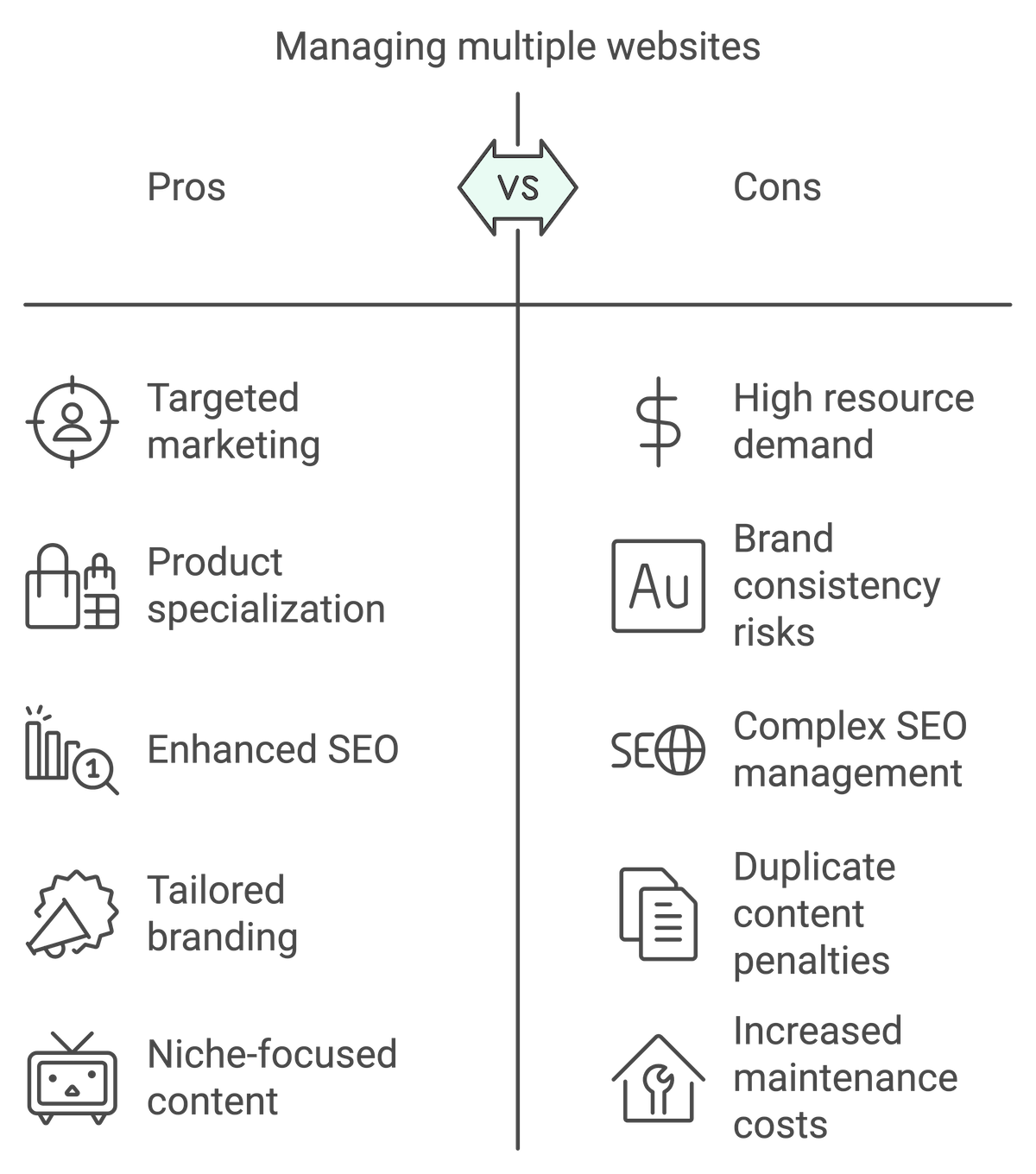Can I Have Multiple Websites for My Business? (Find out with this quiz!)
By: Hayden Jarman

Have you ever wondered if having more than one website could benefit your business?
Whether you're targeting specific audiences, offering varied products, or optimizing SEO, managing multiple sites can provide a strategic edge. However, this approach has its own challenges.
Below, we’ll break down the reasons for multiple sites, considerations for SEO, potential costs, and tactics for maximizing your online presence.
Table of Contents:
- Why Businesses Opt for Multiple Websites
- Key Data and Considerations
- SEO Essentials for Multiple Websites
- Strategic Tables and Lists
- Practical Applications for Multiple Websites
- Essential Tools for Managing Multiple Sites
- Subdomains vs. Separate Domains
- Challenges and Practical Considerations
- Avoiding Pitfalls with Multi-Website Strategies
- Final Thoughts
📝 Is Multiple Website Management Right for Your Business? Self-Assessment Quiz
Answer the questions below to see if managing multiple websites aligns with your goals and resources.
Why Businesses Opt for Multiple Websites
Creating multiple websites can serve several strategic purposes.
Here are some key benefits:
Targeted Marketing for Unique Audiences
Individual websites allow you to tailor branding and messaging for specific customer groups.
For instance, one website could cater to luxury buyers, while another focuses on budget-conscious shoppers. This segmentation helps capture each audience's unique preferences without overwhelming a single site with unrelated content.
Highlight Different Product Lines
If you offer a range of services or products, separate websites give each offering room to shine.
By focusing each website on a particular product or service, you can reach the right audience more effectively.
Boost SEO with Specific Keyword Strategies
Using multiple sites for distinct keyword sets can improve your rankings.
Optimizing each site for different keywords allows you to achieve a strong presence in more targeted search results.
Key Data and Considerations
Understanding the consumer landscape and current business trends is essential when deciding to create multiple websites.
Here are some critical statistics to keep in mind:
- 73% of small businesses have a website, with an additional 23.5% planning to create one soon (Zippia).
- 81% of shoppers research a business online before making a purchase. Customers also rely on online reviews (55%) and business websites (47%) to make decisions (Zippia).
- Designing a website can cost between $2,000 and $9,000, with annual maintenance averaging $1,200 (Wix).
These data points underscore that while multiple sites can increase visibility, they require careful planning and resources to maintain.

SEO Essentials for Multiple Websites
Effective SEO practices are crucial for managing multiple websites successfully.
Here are essential SEO considerations for multi-site management:
Domain Authority and Cross-Site Linking
Google prioritizes domain authority, valuing highly credible sites.
When you split your focus across multiple websites, each needs to build its own authority. However, linking strategically between your sites can share authority and enhance visibility across all your domains.
Avoiding Duplicate Content Issues
Search engines penalize duplicate content, so it’s vital to create distinct and original content for each website.
This reinforces the unique value of each site to Google.
Using an Internal Linking Strategy
Leveraging internal links can improve user experience and SEO.
For instance, linking to a blog post on “Why Schema is Important” from different websites not only boosts its authority but also offers valuable information to your audience.
Strategic Tables and Lists
Here are actionable strategies and comparisons to consider:
Website Cost Overview
| Website Type | Design Cost Range | Maintenance Cost |
|---|---|---|
| Small Business | $2,000 - $9,000 | $1,200 annually |
| E-commerce | $5,000 - $15,000 | $2,000 annually |
| CMS-Managed | $3,000 - $8,000 | $1,000 - $2,500 annually |
Potential Advantages of Multiple Websites
-
Audience-Specific Targeting
- Enables tailored messaging.
- Allows for clearer branding for each customer segment.
-
Product or Service Specialization
- Allows for niche-focused SEO.
- Simplifies navigation for targeted users.
-
Enhanced SEO Strategy
- Makes it easier to target unique keywords.
- Increases potential for higher rankings in niche areas.
SEO Tips for Managing Multiple Sites
| SEO Strategy | Purpose | Example Action |
|---|---|---|
| Unique Content Per Site | Avoid duplicate penalties | Customize content for each site’s audience |
| Cross-Site Linking | Build authority across sites | Link to “SEO for Service Businesses” on related pages |
| Use Niche-Specific Keywords | Improve targeting and ranking | Optimize keywords by niche for better visibility |
Practical Applications for Multiple Websites
Using multiple websites provides a variety of strategic benefits.
Here’s how this approach can work in practice:
Niche Marketing for Specific Locations or Services
If your business serves several regions, separate websites tailored to each location help you target local keywords.
For example, if you’re in Wilmington, NC, creating a location-specific website can increase your visibility in local search results. Using localized keywords like “web design Wilmington NC” improves relevance for regional searches, outperforming a single, generalized website.
Separate Websites for Distinct Product Lines
When a business offers widely different services (such as digital marketing and website hosting), individual sites make it easier to focus on each offering.
For example, you could host articles on topics like “Why Integrated Marketing is Best for Growth-Focused Businesses” on one site, while another website centers around hosting services.
Essential Tools for Managing Multiple Sites
Content Management Systems (CMS)
CMS platforms, like WordPress or Joomla, are essential for managing multiple sites.
They allow for seamless content updates, making multi-site management more efficient.
SEO Monitoring Tools
SEO tools like Moz and HubSpot help track performance across all your sites.
Moz’s Rand Fishkin, a respected SEO expert, recommends using data to optimize your strategy. These insights are crucial for keeping your multi-site SEO in check.
Internal Link Management
Organizing links across your sites not only improves user experience but also boosts SEO.
Consider linking to “SEO on Google My Business” to enhance each site’s authority on Google.
Subdomains vs. Separate Domains
Here’s a breakdown of subdomains versus separate domains:
| Site Structure | Pros | Cons |
|---|---|---|
| Subdomain | Easier to manage, shares SEO benefits | Limited SEO autonomy, less authority in niches |
| Separate Domain | Complete SEO control, distinct branding | More costly, requires independent SEO |
Subdomains work well when the websites are closely related, like blog.yoursite.com.
However, separate domains allow each website to build a unique brand identity, ideal for businesses offering different services.
Challenges and Practical Considerations
Multiple websites offer clear benefits but also bring unique challenges.
Resource Demand
Managing multiple websites requires time and money.
Ensure your team has the resources to keep each site updated and optimized.
Brand Consistency Risks
Multiple sites can dilute brand identity.
It's crucial to maintain quality and consistency across sites to avoid confusing customers.
Balancing SEO Efforts
SEO becomes more complex when managing multiple websites.
Moz, founded by SEO expert Rand Fishkin, offers tools to track performance across different sites. Each site should feature distinct, high-quality content to build authority in Google’s rankings.
Avoiding Pitfalls with Multi-Website Strategies
Create Unique Content Strategies
Duplicating content across sites can result in penalties. Each website should offer something distinct to help it stand out.
Internal Linking for SEO
Internal links between your sites improve search engine crawlability and SEO authority.
For example, if one website hosts an article on “How to Use Apple Intelligence,” link to it from other sites where relevant.
Regular Monitoring and Updates
SEO trends change quickly, so it’s essential to monitor each website’s performance through tools like Google Analytics.
Adjust strategies as needed to maintain competitiveness.
Final Thoughts
Establishing multiple websites for a business is a strategy that can amplify your reach and help you target specific audiences effectively.
However, it requires careful planning, resource allocation, and diligent SEO management.
By implementing a structured approach, leveraging the right tools, and following best practices, you can create a multi-website strategy that enhances visibility, supports growth, and keeps each site relevant in search results.
If you're looking to learn more about best practices for managing multiple websites, check out our guide on SEO-Friendly Website Development and explore more strategies for effective multi-site management.
Related Posts:
- Understanding Google’s Local Pack: How to Get Featured
- Google Business Profile FAQs: Everything You Need to Know
- The Best Google Ads Extensions to Boost Your Click-Through Rates
- How to Leverage Facebook Groups for Local Business Leads
- How to Use AI to Write Better Social Media Captions
- How to Optimize Google Reviews to Attract More Customers
- LinkedIn for B2B Marketing Success
- How to Conduct a Social Media Audit (w/ "Audit Readiness" Quiz!)
- Creating a Content Calendar for Consistent Posting
- The Importance of Mobile Optimization in 2024
- Data Privacy Regulations: What Marketers Need to Know
- The Role of Chatbots in Enhancing Customer Service
- SEO for Small Business: The Ultimate Guide to Getting Found Online
- The Role of Keyword Clustering in Modern SEO

